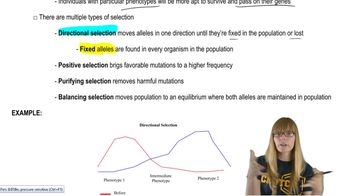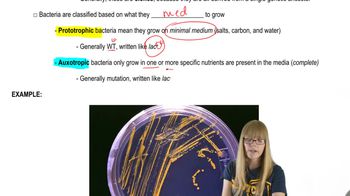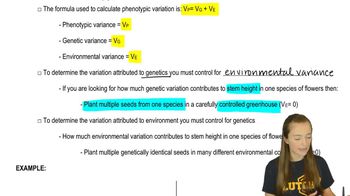Table of contents
- 1. Introduction to Genetics51m
- 2. Mendel's Laws of Inheritance3h 37m
- 3. Extensions to Mendelian Inheritance2h 41m
- 4. Genetic Mapping and Linkage2h 28m
- 5. Genetics of Bacteria and Viruses1h 21m
- 6. Chromosomal Variation1h 48m
- 7. DNA and Chromosome Structure56m
- 8. DNA Replication1h 10m
- 9. Mitosis and Meiosis1h 34m
- 10. Transcription1h 0m
- 11. Translation58m
- 12. Gene Regulation in Prokaryotes1h 19m
- 13. Gene Regulation in Eukaryotes44m
- 14. Genetic Control of Development44m
- 15. Genomes and Genomics1h 50m
- 16. Transposable Elements47m
- 17. Mutation, Repair, and Recombination1h 6m
- 18. Molecular Genetic Tools19m
- 19. Cancer Genetics29m
- 20. Quantitative Genetics1h 26m
- 21. Population Genetics50m
- 22. Evolutionary Genetics29m
20. Quantitative Genetics
Analyzing Trait Variance
Problem 25
Textbook Question
Students in a genetics laboratory began an experiment in an attempt to increase heat tolerance in two strains of Drosophila melanogaster. One strain was trapped from the wild six weeks before the experiment was to begin; the other was obtained from a Drosophila repository at a university laboratory. In which strain would you expect to see the most rapid and extensive response to heat-tolerance selection, and why?
 Verified step by step guidance
Verified step by step guidance1
<span>Identify the two strains of <em>Drosophila melanogaster</em>: one from the wild and one from a laboratory repository.</span>
<span>Consider the genetic diversity of each strain. Wild populations typically have higher genetic diversity compared to laboratory strains, which may have been inbred or selected for specific traits over generations.</span>
<span>Understand that higher genetic diversity in a population can lead to a more rapid and extensive response to selection pressures, such as increased heat tolerance, because there is a greater pool of genetic variations that might confer the desired trait.</span>
<span>Predict that the wild strain is likely to show a more rapid and extensive response to heat-tolerance selection due to its higher genetic diversity, providing more opportunities for beneficial mutations to be present and selected for.</span>
<span>Conclude that the laboratory strain may have a slower or less extensive response due to potentially reduced genetic diversity, limiting the available genetic variations that could be selected for increased heat tolerance.</span>
Recommended similar problem, with video answer:
 Verified Solution
Verified SolutionThis video solution was recommended by our tutors as helpful for the problem above
Video duration:
1mPlay a video:
Was this helpful?
Key Concepts
Here are the essential concepts you must grasp in order to answer the question correctly.
Natural Selection
Natural selection is a fundamental mechanism of evolution where organisms better adapted to their environment tend to survive and produce more offspring. In the context of the experiment, the wild strain of Drosophila may have already undergone adaptations to local environmental conditions, including heat tolerance, making them potentially more responsive to selection pressures.
Recommended video:
Guided course

Natural Selection
Genetic Variation
Genetic variation refers to the diversity in gene frequencies among individuals within a population. This variation is crucial for evolution, as it provides the raw material for natural selection. The wild strain may exhibit greater genetic diversity due to its exposure to varying environmental conditions, which could enhance its ability to adapt to heat tolerance compared to the laboratory strain.
Recommended video:
Guided course

Genomic Variation
Laboratory vs. Wild Strains
Laboratory strains of organisms, such as Drosophila, are often bred under controlled conditions and may lack the genetic diversity and adaptive traits found in wild populations. This can limit their ability to respond to environmental changes, such as increased temperatures. In contrast, the wild strain is likely to have evolved traits that confer survival advantages in fluctuating environments, making it more likely to show rapid adaptation to heat tolerance.
Recommended video:
Guided course

Bacteria in the Laboratory

 8:34m
8:34mWatch next
Master Analyzing Trait Variance with a bite sized video explanation from Kylia Goodner
Start learningRelated Videos
Related Practice


